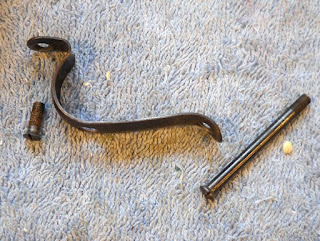Still sanding along. Turned my attention to the left grip panel.

Need to create a thumb shelf and add some finger grooves. Held the grip in my right hand and roughly sketched some lines in about the right spot.

And sanded out the rest. There's that nice piece of grain.

The hard part here is shaping the rear of the grip as it curves toward the grip frame. Don't want to overdo it--as that will leave a hollow against the gun. Tracing the grip frame onto the panel and working to just shy of the line is the way to go.

Looks promising.

Thinning the top edge.

Adding the finger grooves. Again, located by mounting the grip to the gun and tracing my fingers.


A couple views.

Grips roughed to shape and screwed into place. Need a spacer the thickness of the grip frame to fill the gap at the bottom. The grip frame is 0.500" thick and I didn't have a piece of walnut that thin. Rather than sand, I took the easy way out and went back to
Terry Lumber and had them plane a piece of a scrap walnut board down to half inch. And when I told Chad "half an inch" he dialed the machine to half an inch. I pulled out a caliper and miked the board. It was 0.4995" to 0.5000" over 6 or so inches. He didn't even look nervous as I measured it. The kid is good.

Just traced around the bottom of the grip frame.

Cut just inside the line. Sharp-eyed readers will note this is not the piece shown below. I didn't leave quite enough wood in the heel, making this a "prototype".

Spacer take two.

Just needs blended into the grips.

Cut and sanded the spacer to fit the left and right panels.

Close. I'll blend these together by sanding then stippling.

Affixed the spacer to the left grip panel via
Gorilla Glue and clamps.

I want the glue to coat 100% of the surfaces and I want some squeeze out on all edges.

After the glue dried, I screwed the grips to the frame and sanded the bottom edges as one.

Getting there.

Back to the right panel and the final shaping. Enlarged and deepened the palm depression with a round burr. It's pretty sharp and left a decent finish that won't require much in the way of finish sanding. A dull burr would likely just rip the wood and add additional work.

Cut a palm shelf.

Cut the inside corners square, then sanded the outer edges and did some quick shaping.

Test fit.

Another view.

Easiest way to align everything was to leave it all attached. (It's just dust, it'll wipe or blow off.)
Drilled for the palm shelf bolts. I drilled through the shelf and into the right grip. Then removed the grip and finished the holes.

I pinned the first hole with a transfer punch so the grip wouldn't twist while drilling the second hole.

Marked the high and low spots for the adjustment slot and used a 4-flute center cutting endmill. Cut the wood like hot butter.

Counterbored the inside of the slot using a forstner bit.

This recessed track will hold square nuts that the shelf will bolt into.

Another test fit. It's finally coming together.
More soon.














































































